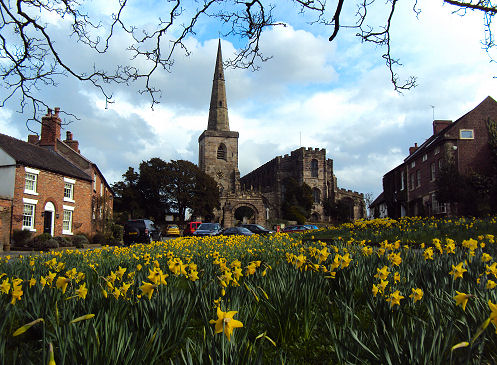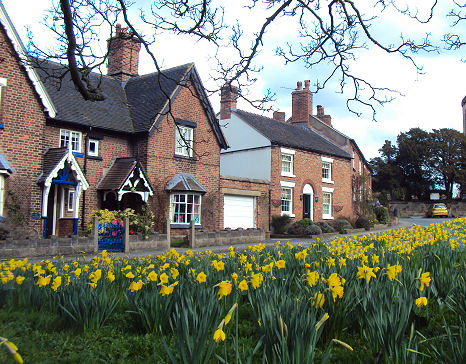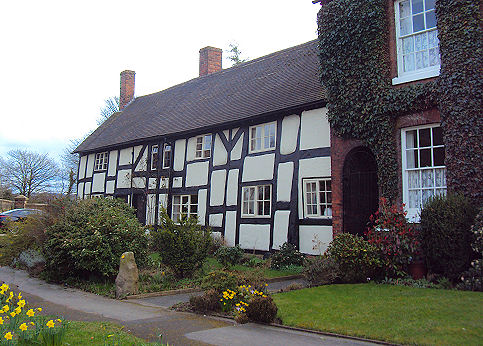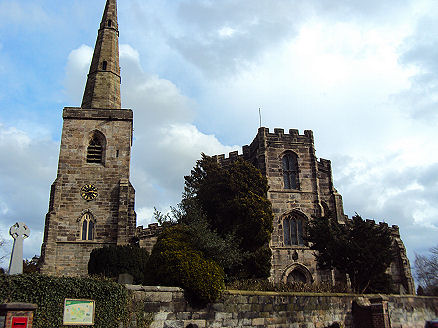Astbury
OS Grid ref:- SJ 846 615
Astbury is one of the most picturesque villages in the county of Cheshire, and is located on the eastern edge of the Cheshire plain, a few miles south west of Congleton. An ancient settlement, the village is mentioned in the Domesday Book of 1086, where it would appear to have been an important pre-Conquest estate centre.

A Roman settlement existed near Bent Farm in the first century A.D. The name means 'eastern borough or defence', the village was probably so named in relation to the major pre-Conquest estate centre of Sandbach. It was held by one Gilbert de Venables, known as Gilbert the hunter in Domesday Book, who held the land from the Earl of Chester. The Astbury entry reads as follows :-
' Gilbert the hunter holds of the earl Newbold. Wulfgeat held and was a free man [There is] 11/2 hides gelding. There is land for 5 ploughs. A radman has one plough there and a priest one plough. [there are] 3 villagers and 2 bordars. [There is] 1 acre of meadow there and wood 1 league in length and as much wide and 2 enclosures there. In the time of King Edward it was worth 20 shillings, now 8.'

The attractive triangular village green, which is covered in a colourful carpet of dafodills in the springtime, is overlooked by the church and characterful ivy-clad cottages which were built for agricultural workers in the nineteenth century. Glebe Farm, to the east of the church, dates from the sixteenth century and was once the village rectory.

The Egerton Arms, a nineteenth century coaching inn, serves excellent meals in its restaurant and stands adjacent to the church.
St. Mary's Church
St Mary's Church, one of the finest in Cheshire, has an unusual design with its steeple standing apart from the main church, they are joined by a passage with a porch. The yellow sandstone chancel is of Norman origin, whilst most of the building dates back to the fourteenth and fifteenth centuries. The millstone grit tower was constructed towards the end of the thirteenth century. The discovery nearby of fragments of stone with Saxon decoration, coffin lids, and the lower stages of a cross, dating from before the Norman conquest, suggest that an earlier Saxon church may have previously occupied the site.

The interior is magnificent, despite being damaged by Roundhead soldiers who stabled their horses there in the period of the Civil War. Sir William Brereton and his followers made Astbury their headquarters during the siege of Biddulph Hall. The stained glass windows were smashed but the vicar saved the fragments of the medieval glass and they were re-assembled.

Part of a Saxon cross shaft, dating from the late 10th or the 11th century, is displayed to the rear of the Church, just above a doorway in the North West corner. Spirals and typical Anglo-Saxon curved motifs are visble on the outward facing side, . Re-used stones which once formed part of an Anglo-Saxon cross can be seen in the interior wall of the vestry.

The nave and chancel are separated by a rood screen and tall columns soar upward to the camber beam roof. The superb rood screen, dating from 1500, is elaborately carved with representations of birds, roses, vines and foliage, it has ten bays with lierne vaulting. The chancel stalls date from around the same period. The church contains many interesting medieval features, including well preserved wall paintings depicting St. George, and a fine stained glass panel showing St. Anne teaching the Virgin Mary to read. It also boasts a magnificent carved and painted ceiling and panelled oak pews. The south chapel contains an effigy of a late fourteenth century knight.

The royal arms of Charles II are in the north aisle. The church contains more medieval fittings and furniture than any other Cheshire church, including contains two sanctuary chairs and six old chests, one of which is iron-bound and dates from the thirteenth century. The lectern is one of the oldest eagle lecterns in Britain.
The Eagle lecturn- one of the oldest in Britain

In the churchyard stands the canopied tomb of a member of the Venables family, now much weathered, it dates from the late thirteenth century. There is also an ancient hollow yew tree in the south side of the churchyard which has been scientifically dated to be a 2,000 years old, its hollow trunk now needs to be supported.
.Nearby places of interest
Astbury Mere Country Park, owned by the charity Astbury Mere Trust. The park consists of 14ha of open space. Visitors can enjoy panoramic views over Astbury Mere and the surrounding rural landscape. There is a visitor centre, 3km of all weather paths, an easy access trail and excellent footpath links into the local countryside.
Bosley Cloud lies on the Cheshire-Staffordshire border just a couple of miles to the west of the Peak District National Park. It rises to a height of 343 metres (1,125 feet).
